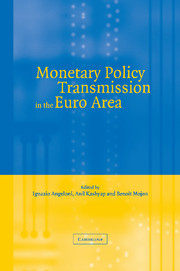 Monetary Policy Transmission in the Euro Area
Monetary Policy Transmission in the Euro Area Book contents
- Frontmatter
- Contents
- List of contributors
- Foreword by O. Issing
- Acknowledgements
- List of abbreviations
- Introduction
- Part 1 Macroeconometric evidence on the transmission mechanism in the euro area
- Part 2 Firms' investment and monetary policy: evidence from microeconomic data
- Part 3 The role of banks in the transmission: evidence from microeconomic data
- 14 Financial systems and the role of banks in monetary policy transmission in the euro area
- 15 The reaction of bank lending to monetary policy measures in Germany
- 16 Is there a bank-lending channel of monetary policy in Spain?
- 17 Is there a bank-lending channel in France? Evidence from bank panel data
- 18 Is there a bank-lending channel of monetary policy in Greece? Evidence from bank-level data
- 19 The Italian banking system and monetary policy transmission: evidence from bank-level data
- 20 The impact of monetary policy on bank lending in the Netherlands
- 21 The cross-sectional and the time dimension of the bank-lending channel: the Austrian case
- 22 The bank-lending channel of monetary policy: identification and estimation using Portuguese micro bank data
- 23 Transmission of monetary policy shocks in Finland: evidence from bank-level data on loans
- Part 4 Monetary policy in the euro area: summary and discussion of the main findings
- Appendix
- References
- List of figures
- List of tables
- Subject index
- Author index
18 - Is there a bank-lending channel of monetary policy in Greece? Evidence from bank-level data
Published online by Cambridge University Press: 22 September 2009
- Frontmatter
- Contents
- List of contributors
- Foreword by O. Issing
- Acknowledgements
- List of abbreviations
- Introduction
- Part 1 Macroeconometric evidence on the transmission mechanism in the euro area
- Part 2 Firms' investment and monetary policy: evidence from microeconomic data
- Part 3 The role of banks in the transmission: evidence from microeconomic data
- 14 Financial systems and the role of banks in monetary policy transmission in the euro area
- 15 The reaction of bank lending to monetary policy measures in Germany
- 16 Is there a bank-lending channel of monetary policy in Spain?
- 17 Is there a bank-lending channel in France? Evidence from bank panel data
- 18 Is there a bank-lending channel of monetary policy in Greece? Evidence from bank-level data
- 19 The Italian banking system and monetary policy transmission: evidence from bank-level data
- 20 The impact of monetary policy on bank lending in the Netherlands
- 21 The cross-sectional and the time dimension of the bank-lending channel: the Austrian case
- 22 The bank-lending channel of monetary policy: identification and estimation using Portuguese micro bank data
- 23 Transmission of monetary policy shocks in Finland: evidence from bank-level data on loans
- Part 4 Monetary policy in the euro area: summary and discussion of the main findings
- Appendix
- References
- List of figures
- List of tables
- Subject index
- Author index
Summary
Introduction
This chapter examines the implications of differential bank characteristics for the loan supply behaviour of Greek banks, using monthly panel data that cover the second half of the 1990s, and assesses the importance of these cross-sectional differences for the operation of the bank-lending channel. Implicit in this approach, namely that the response of banks to changes in monetary policy could differ depending on their characteristics (such as size or liquidity), is the assumption that, when asymmetries are present, loan-supply shifts – a necessary condition for the operation of the lending channel – may be identified. The empirical results derived from bank-level data indicate that bank-specific characteristics were found to systematically shift the loan-supply function. This result is consistent with previous time-series evidence (Brissimis and Kastrissianakis, 1997) according to which the bank-lending channel operates in Greece although its importance diminished in the 1990s with the financial liberalisation.
The remainder of the chapter is divided as follows. Section 2 presents an overview of recent developments in the Greek banking system and its characteristics that may be pertinent to the operation of the lending channel. Section 3 uses two approaches for analysing the role of banks in monetary transmission. One employs a reduced form equation linking monetary policy and distributional variables to bank loans in the spirit of Kashyap and Stein's (1995) work.
- Type
- Chapter
- Information
- Monetary Policy Transmission in the Euro AreaA Study by the Eurosystem Monetary Transmission Network, pp. 309 - 322Publisher: Cambridge University PressPrint publication year: 2003
- 10
- Cited by
